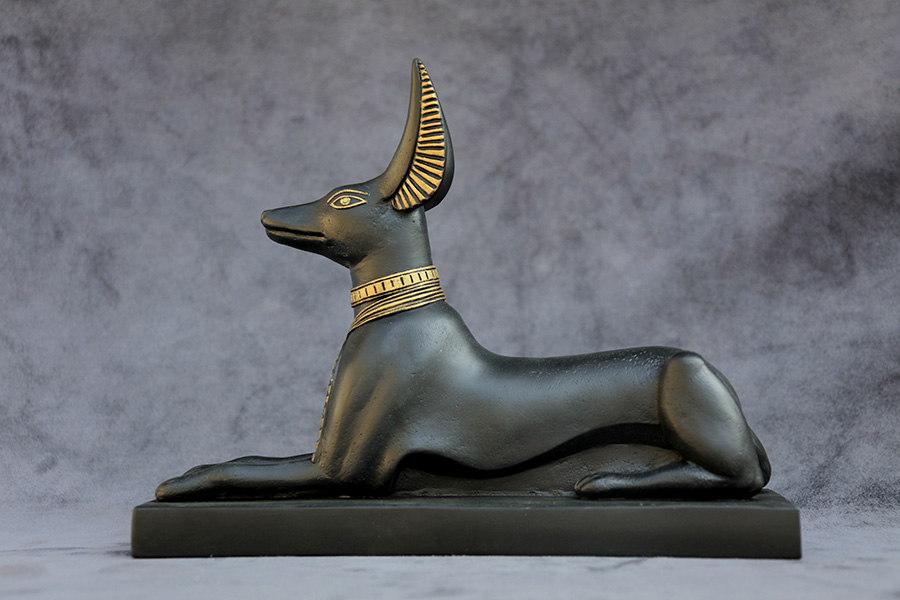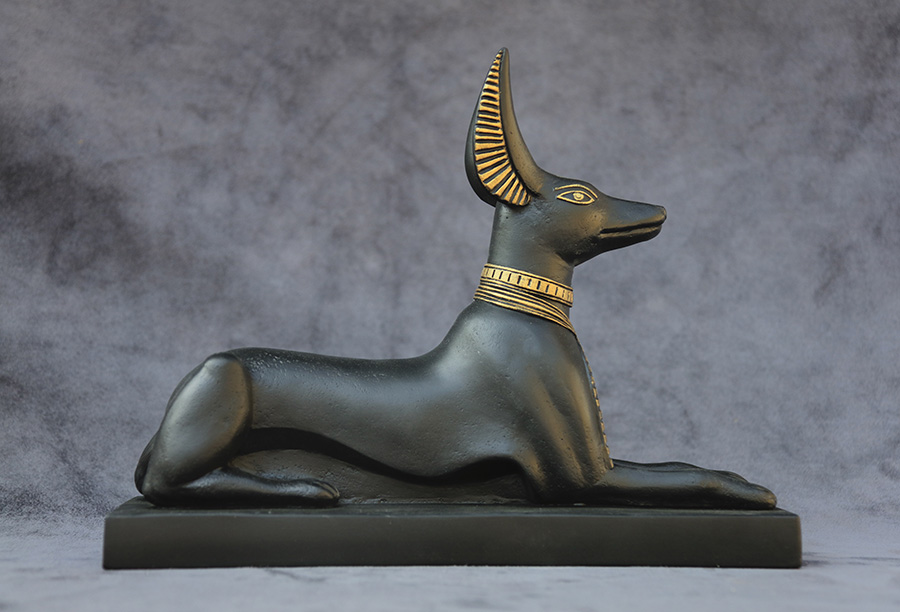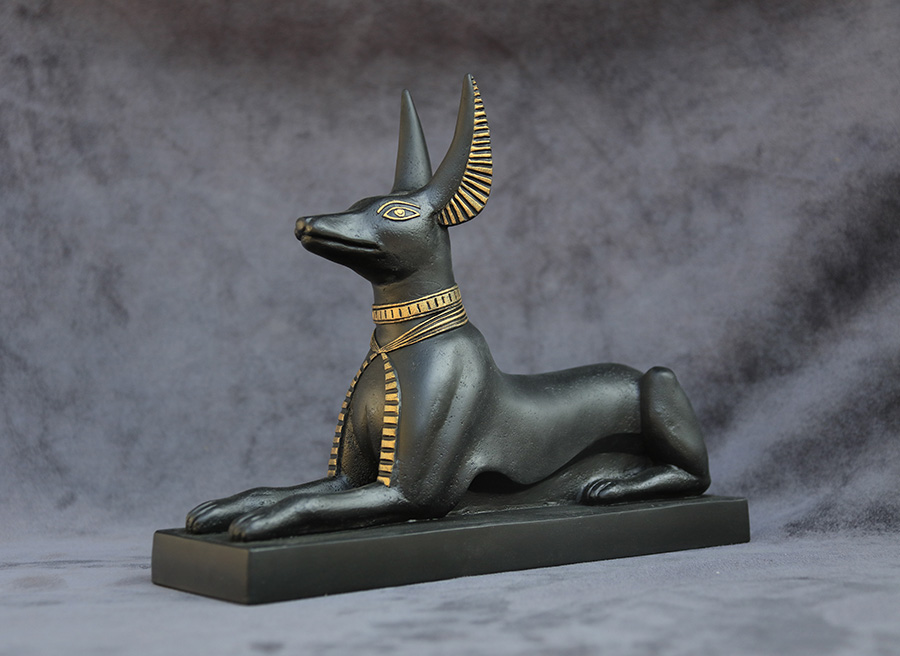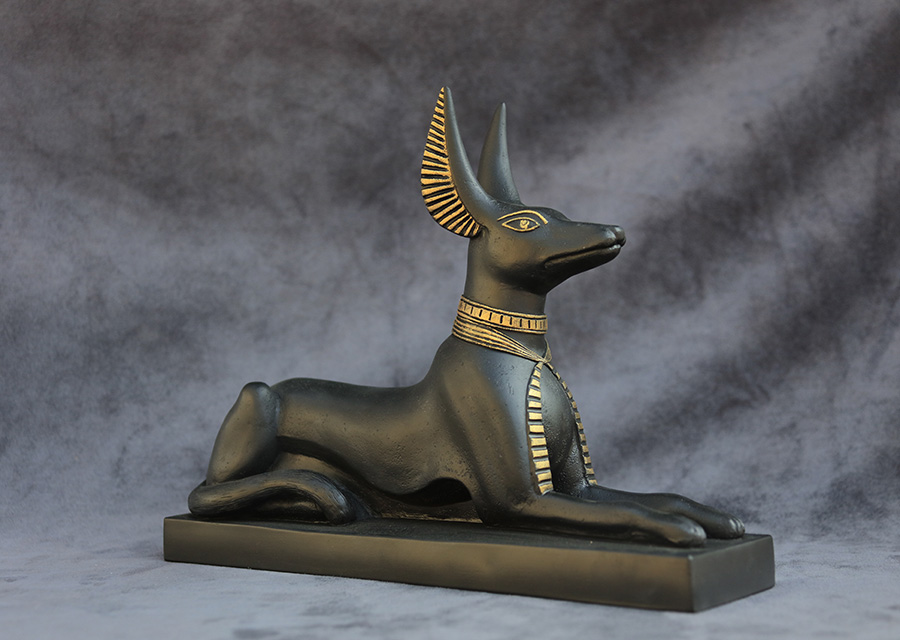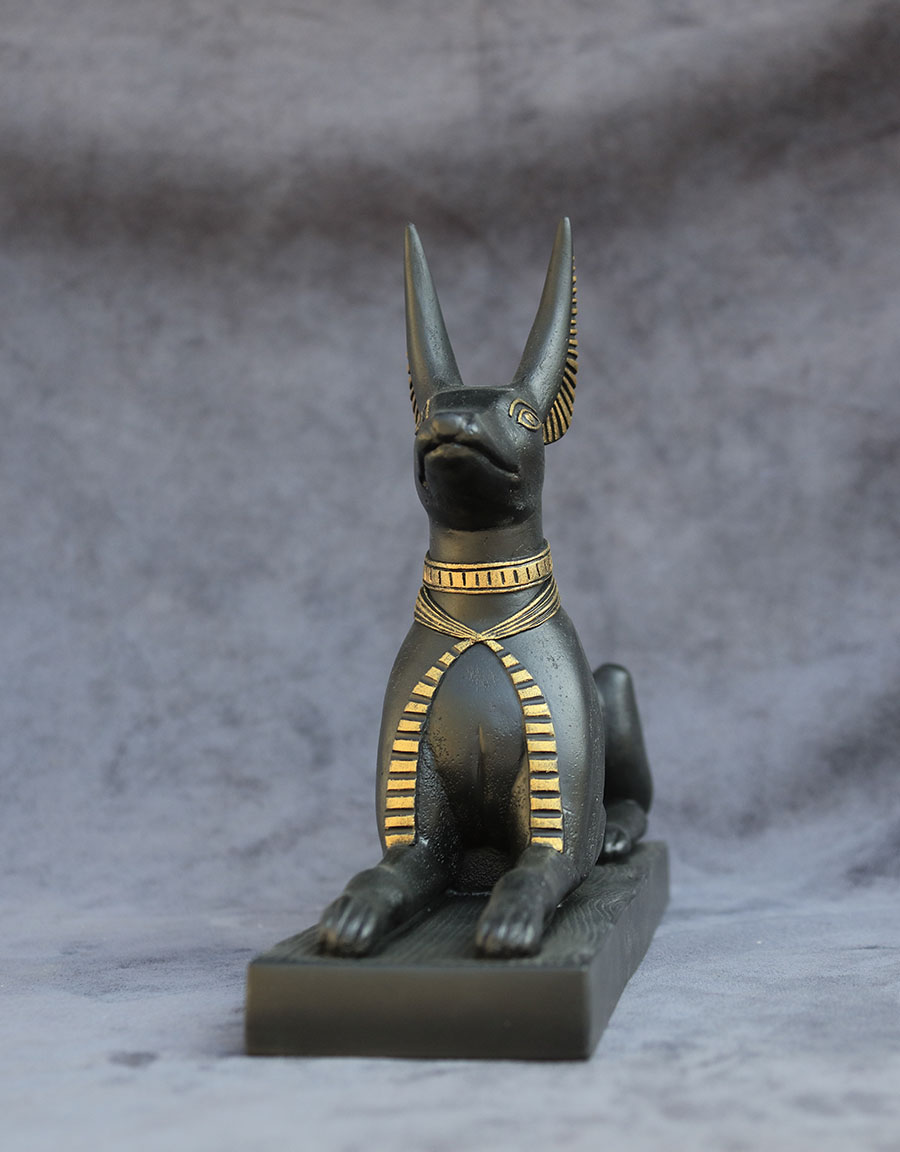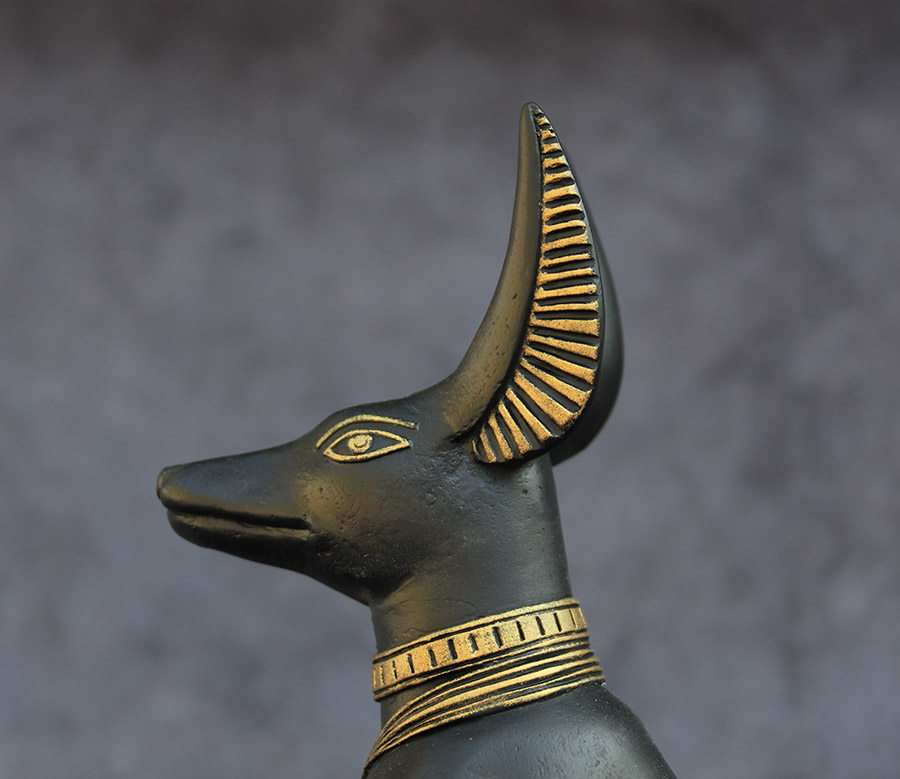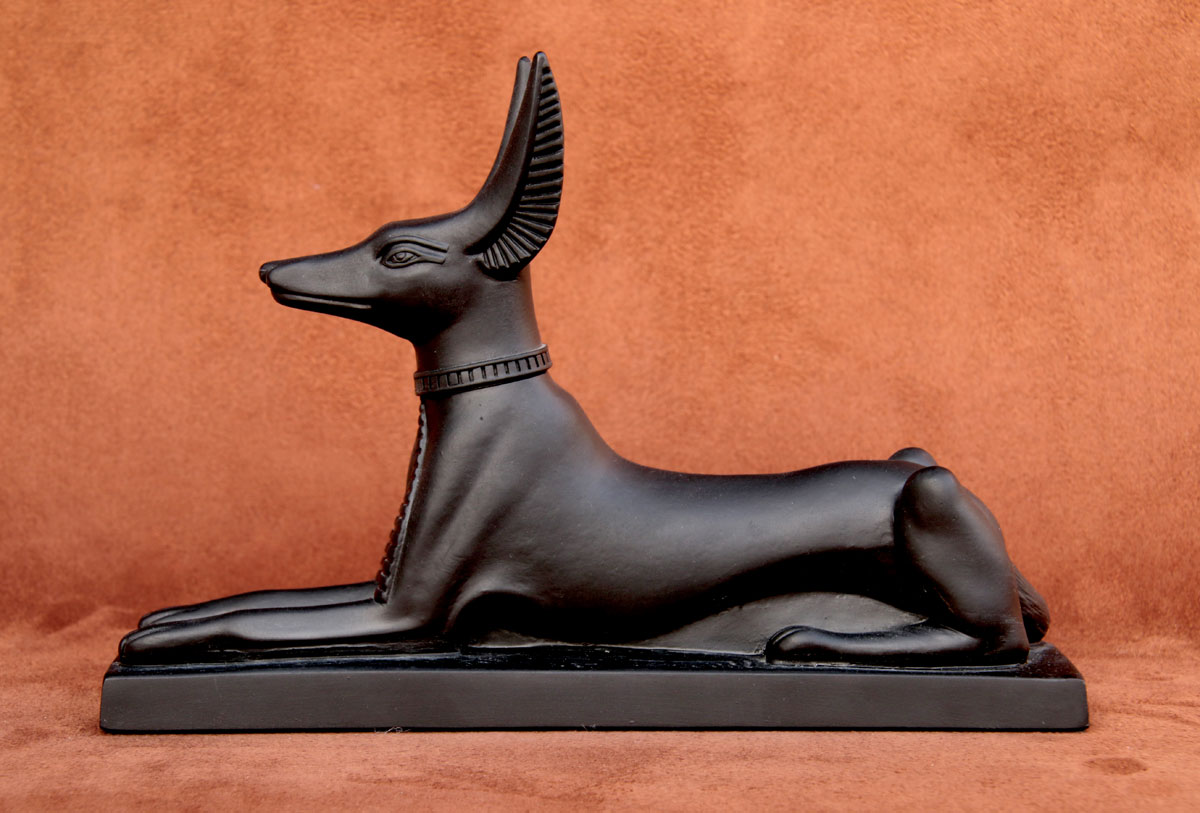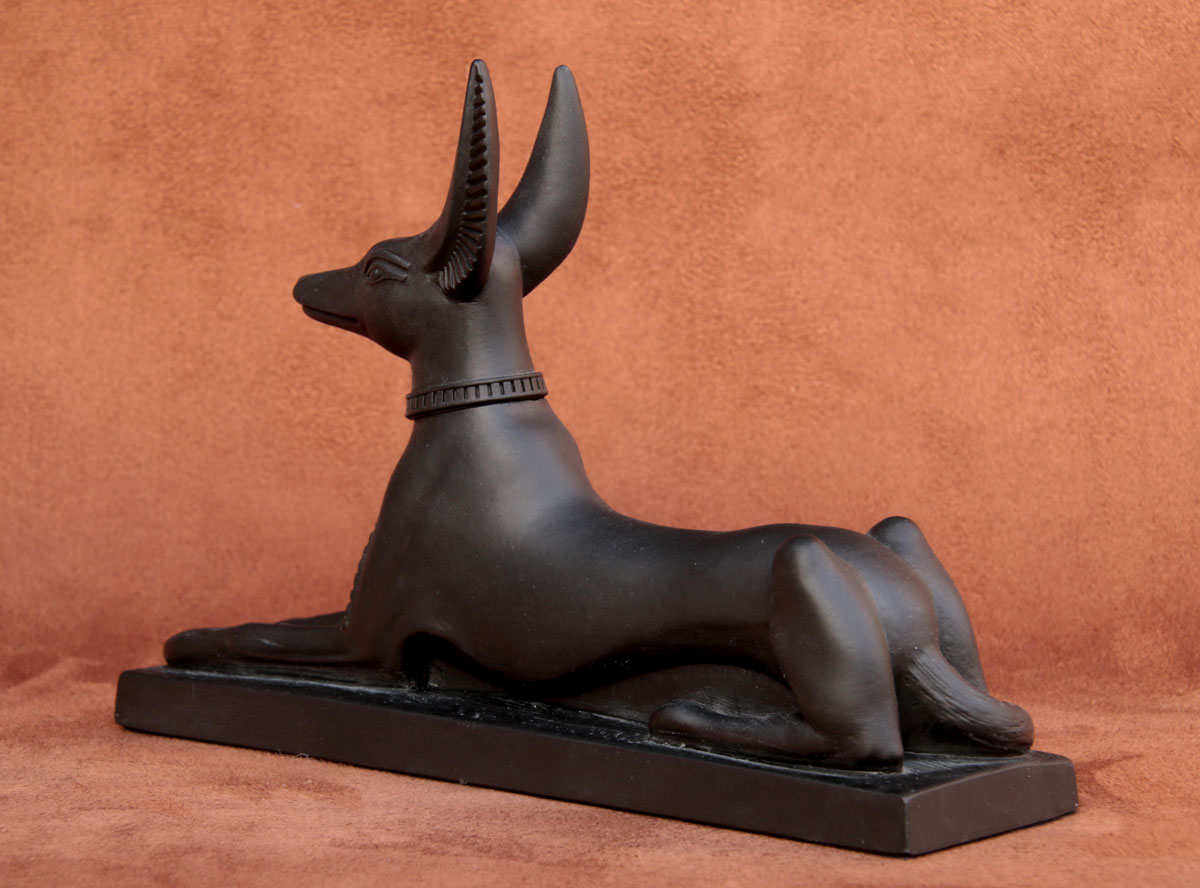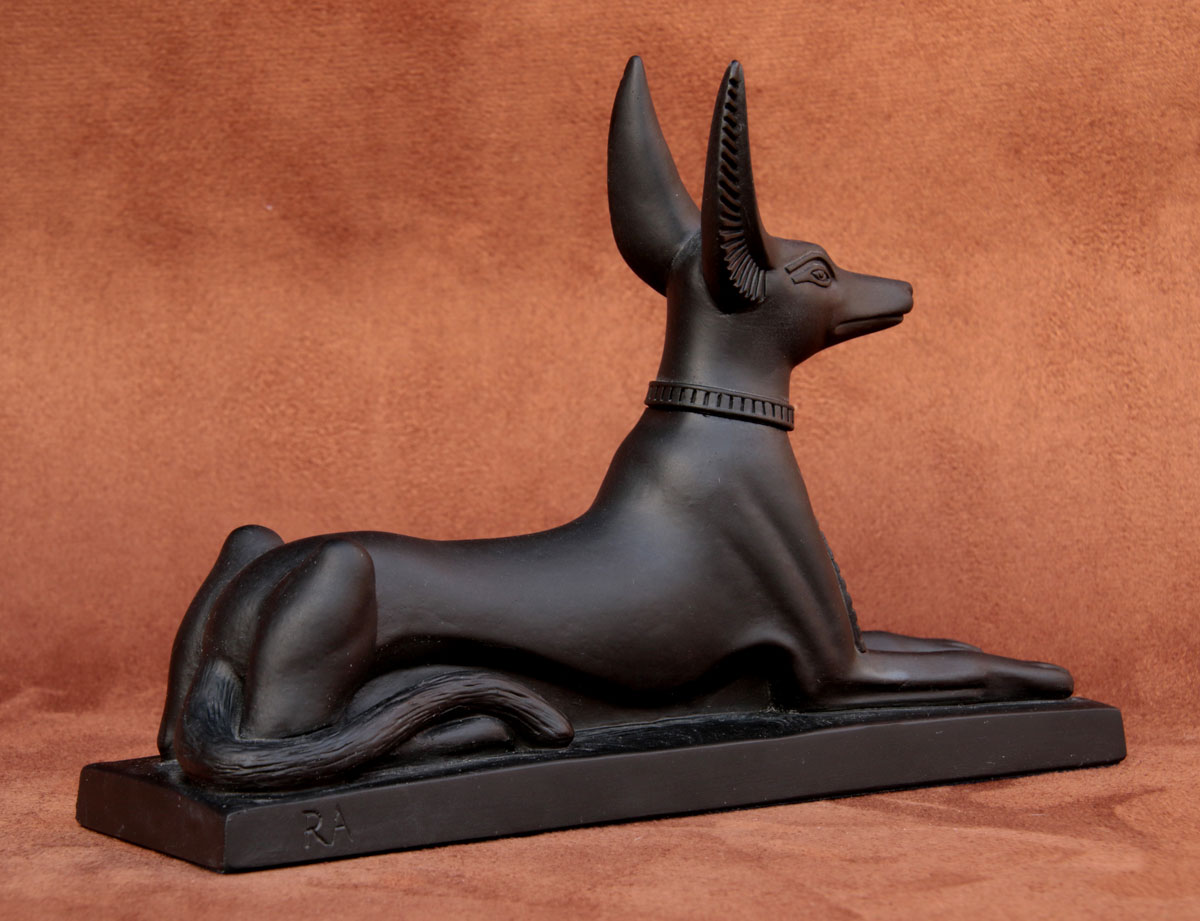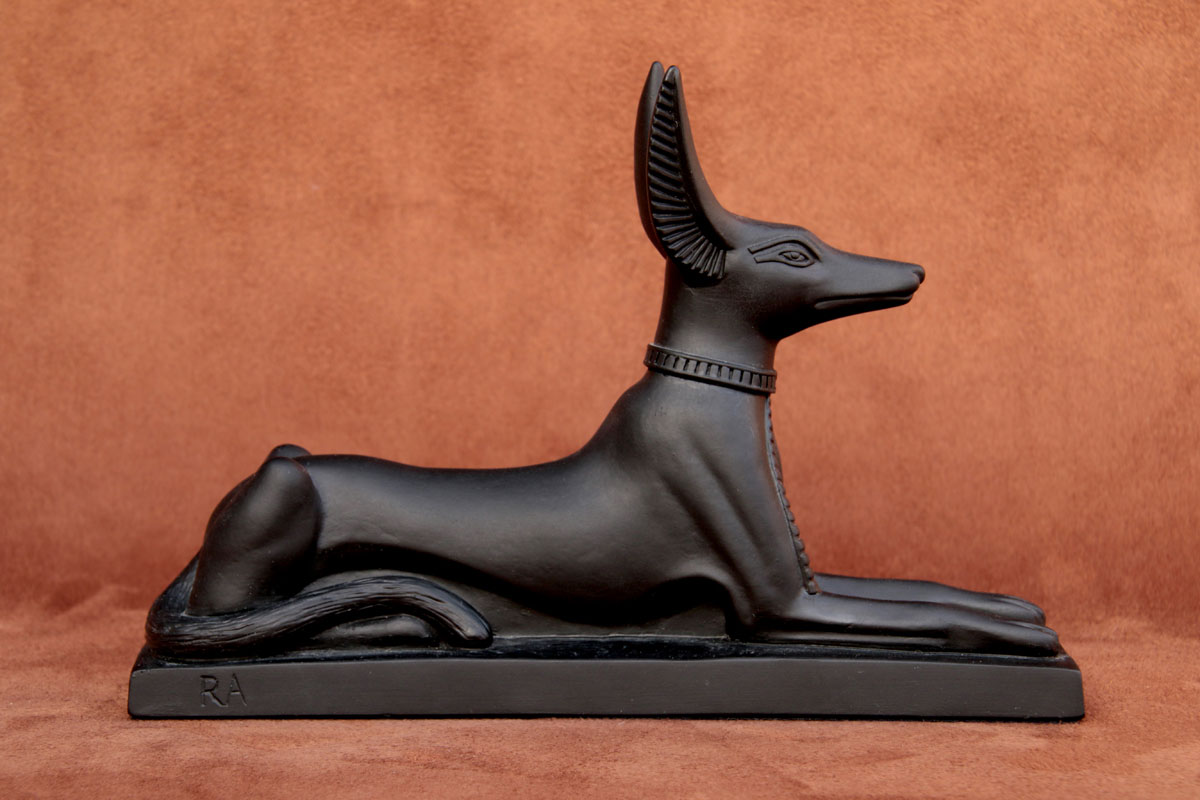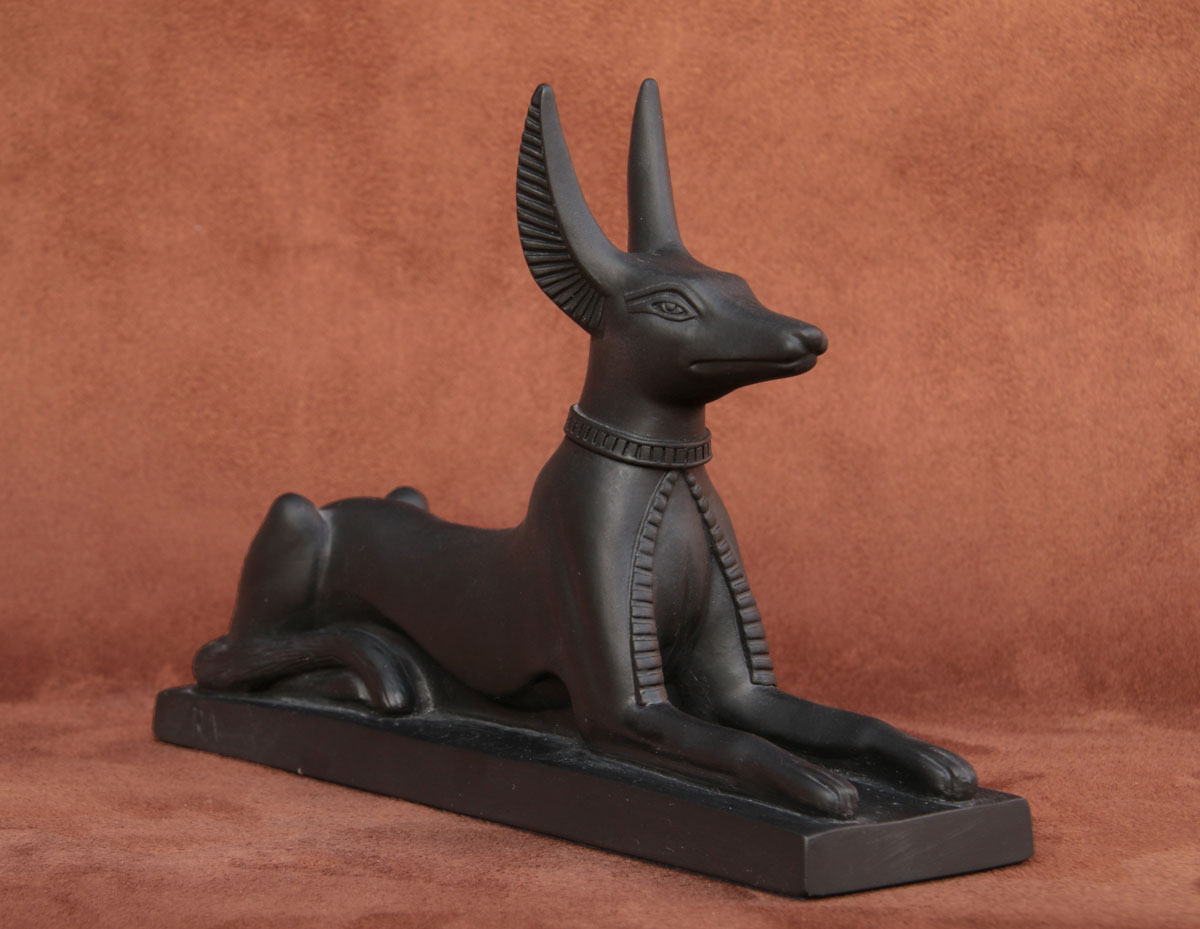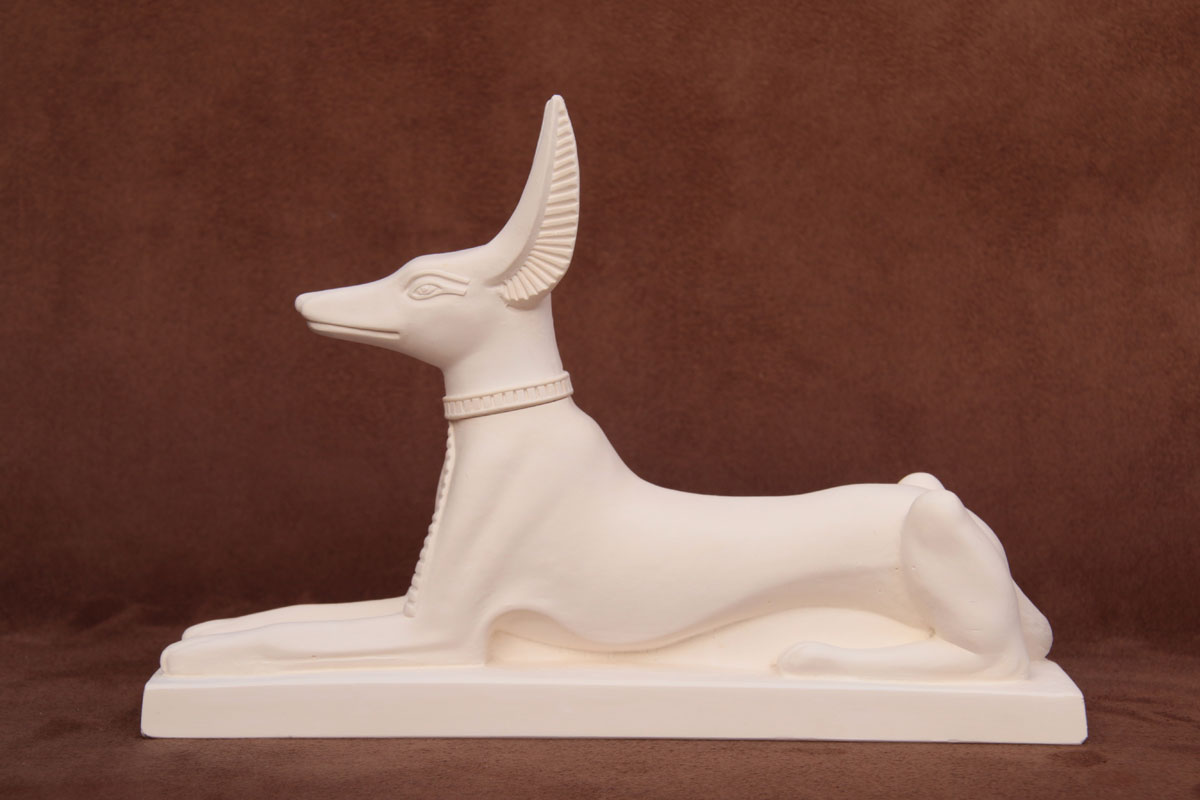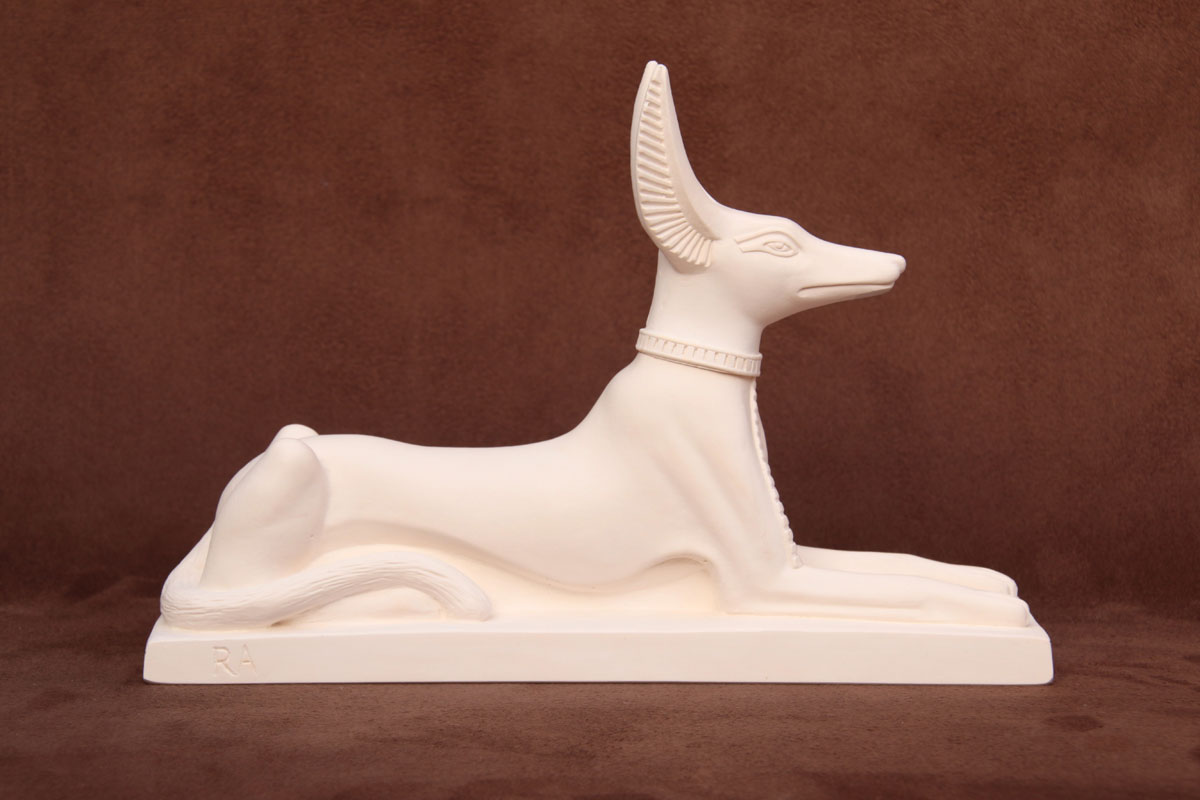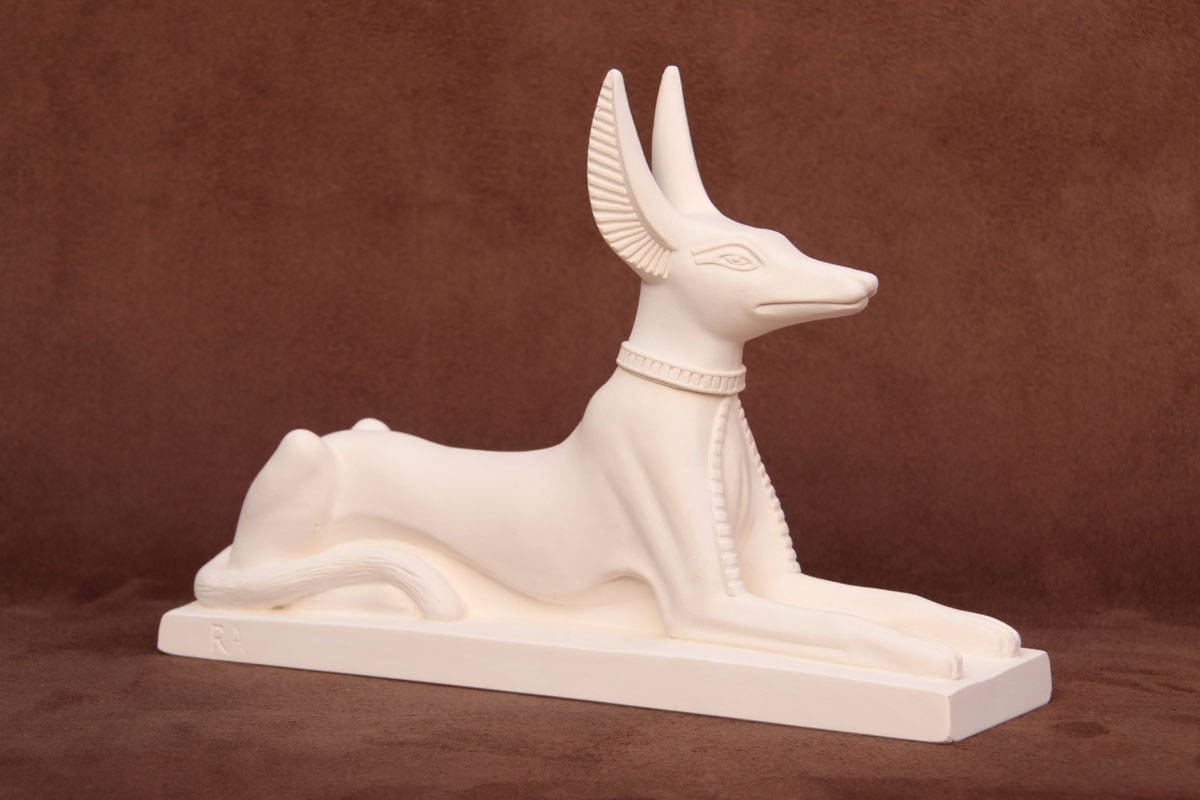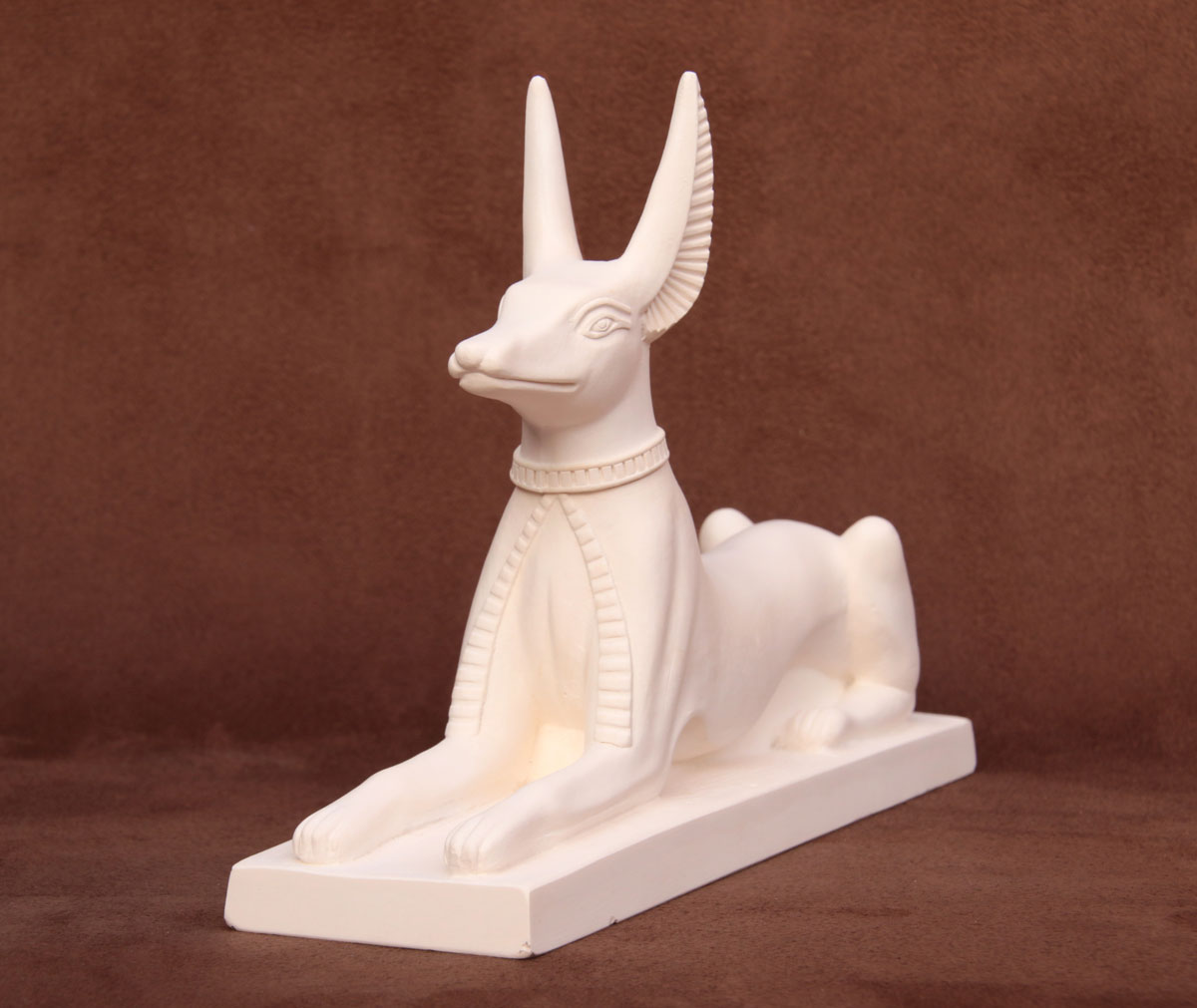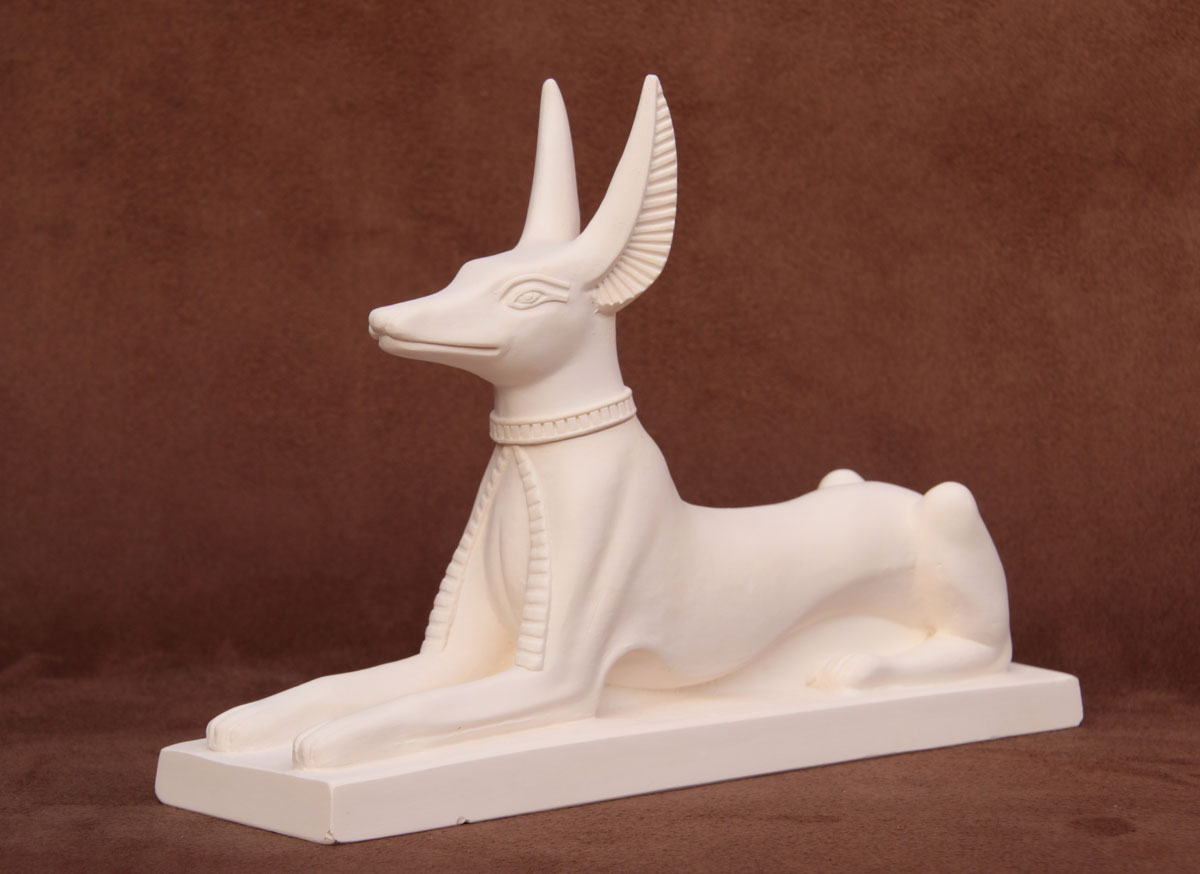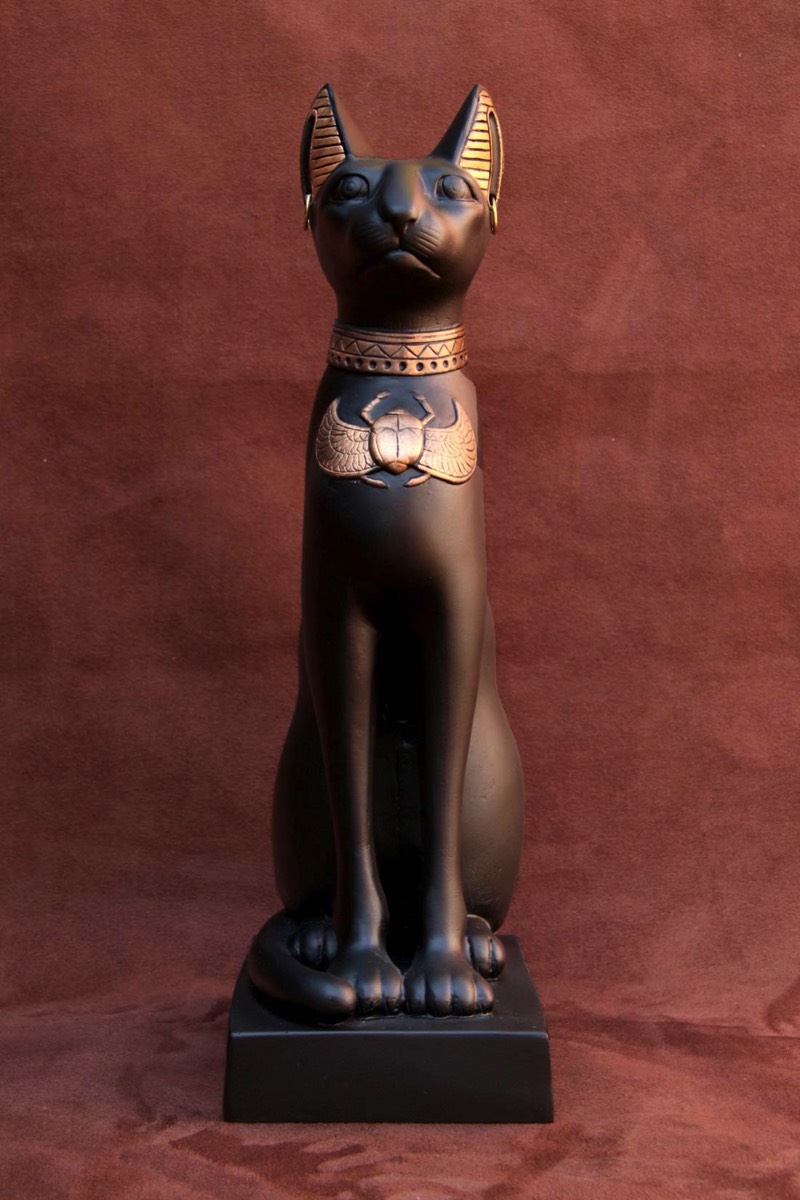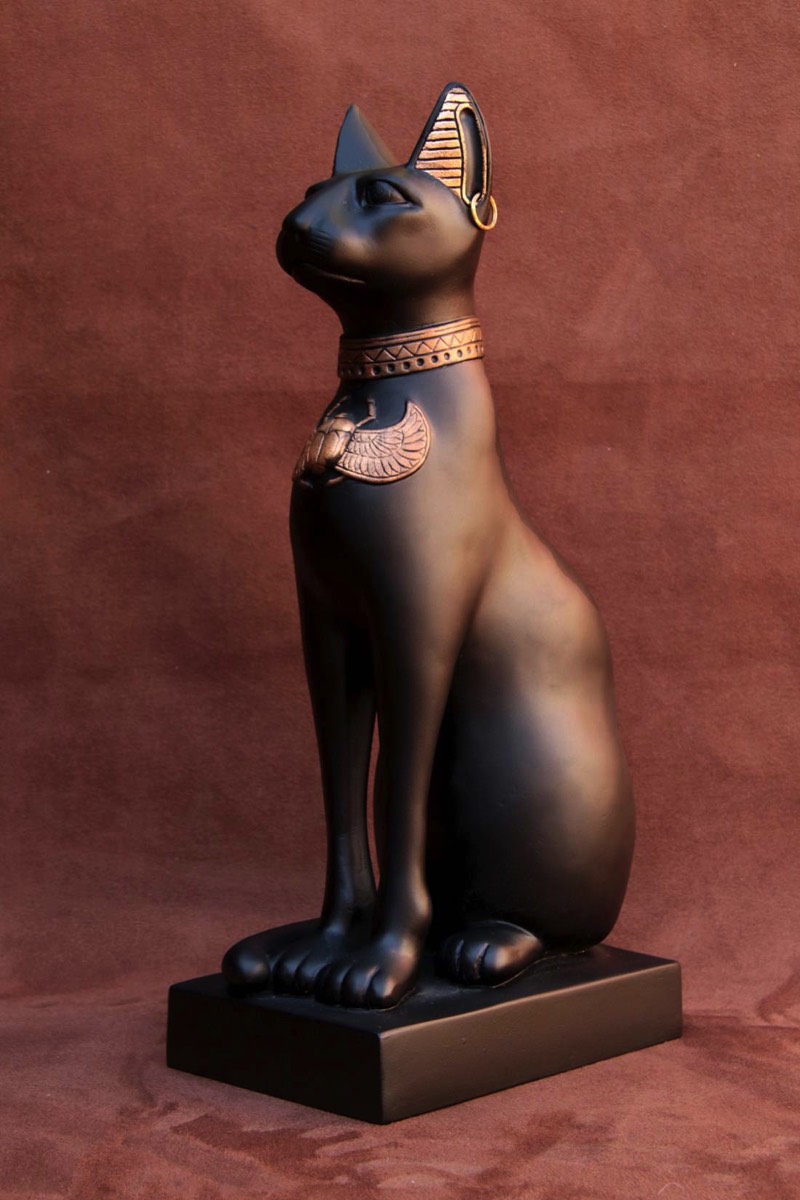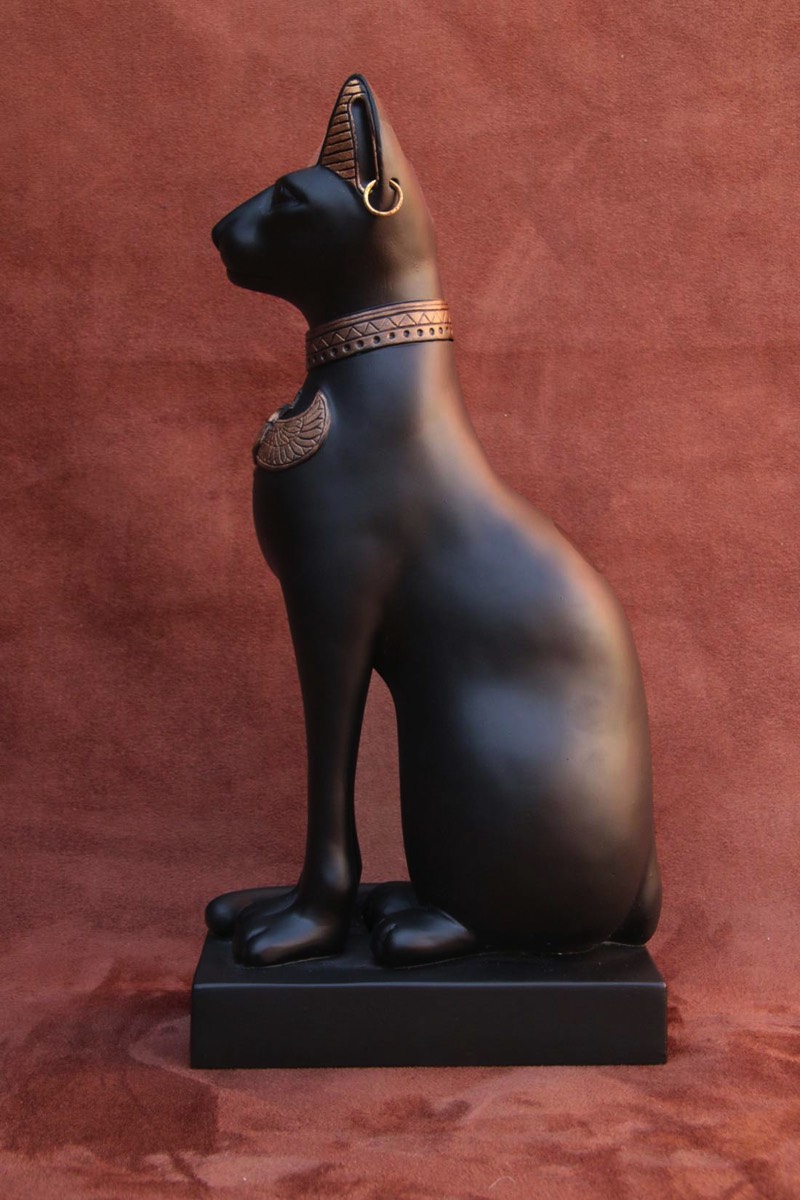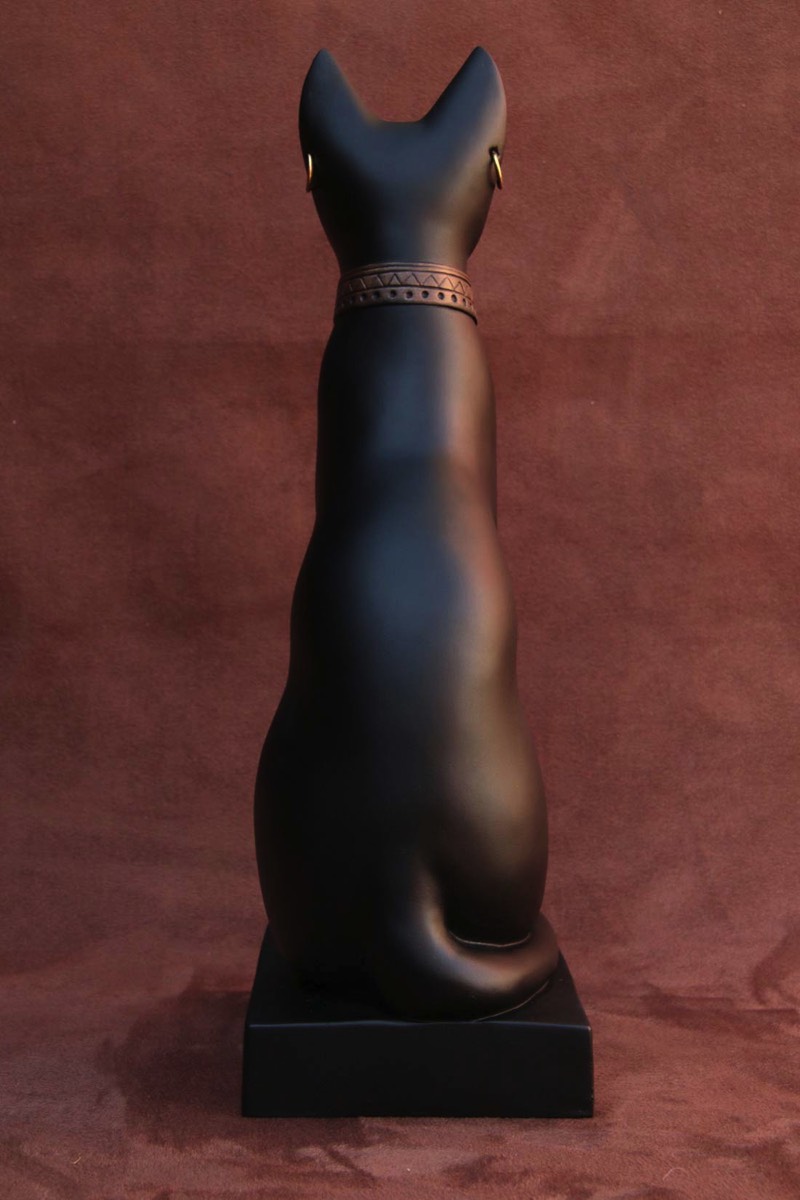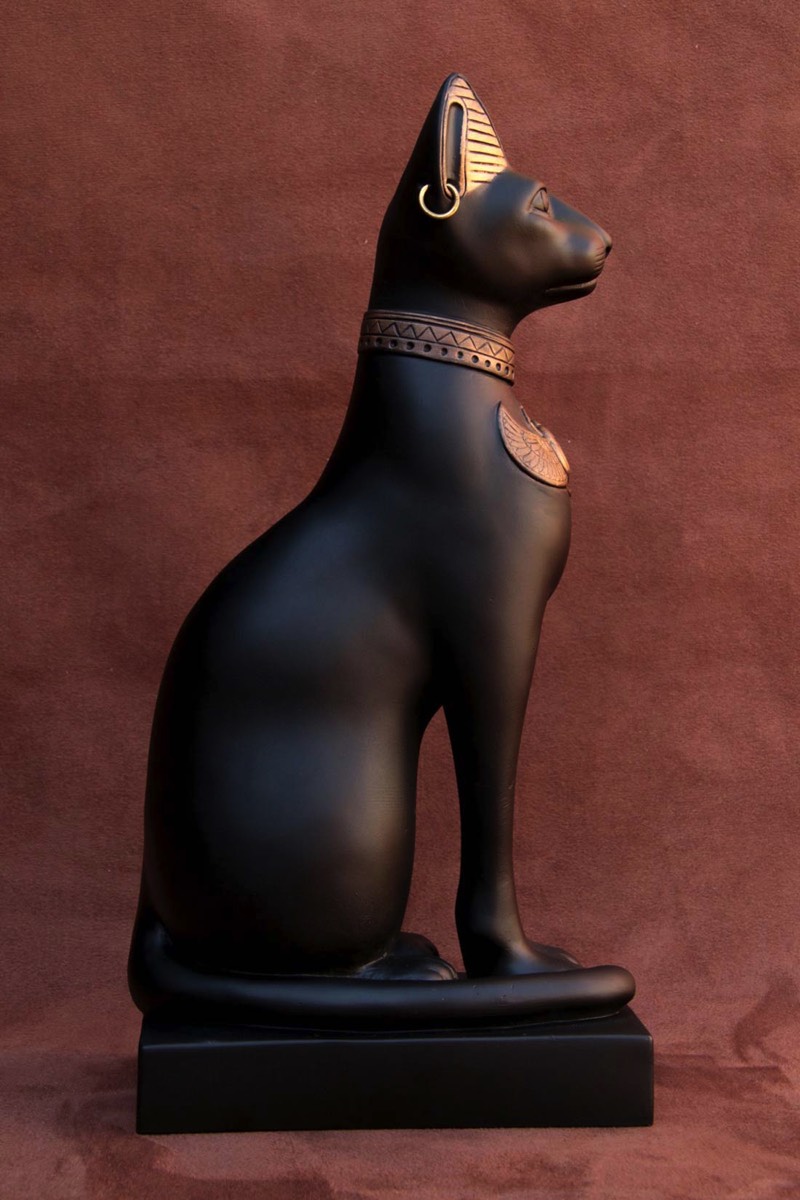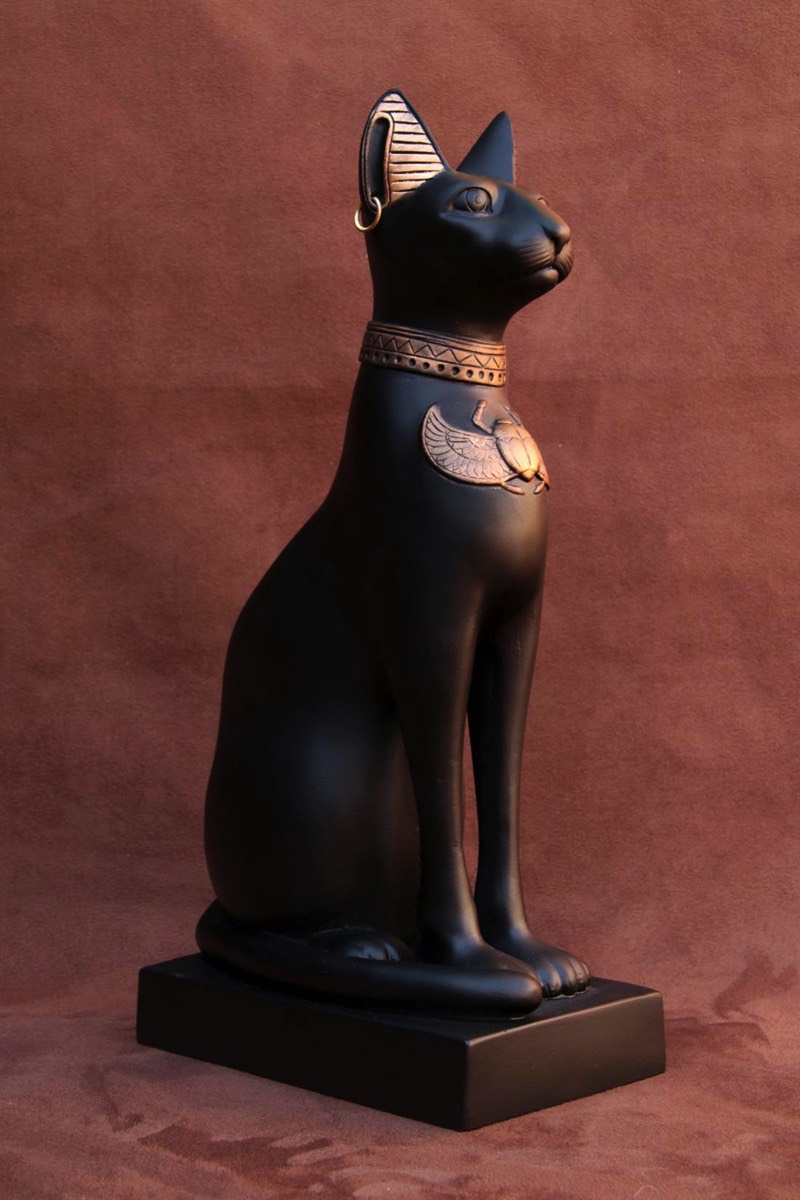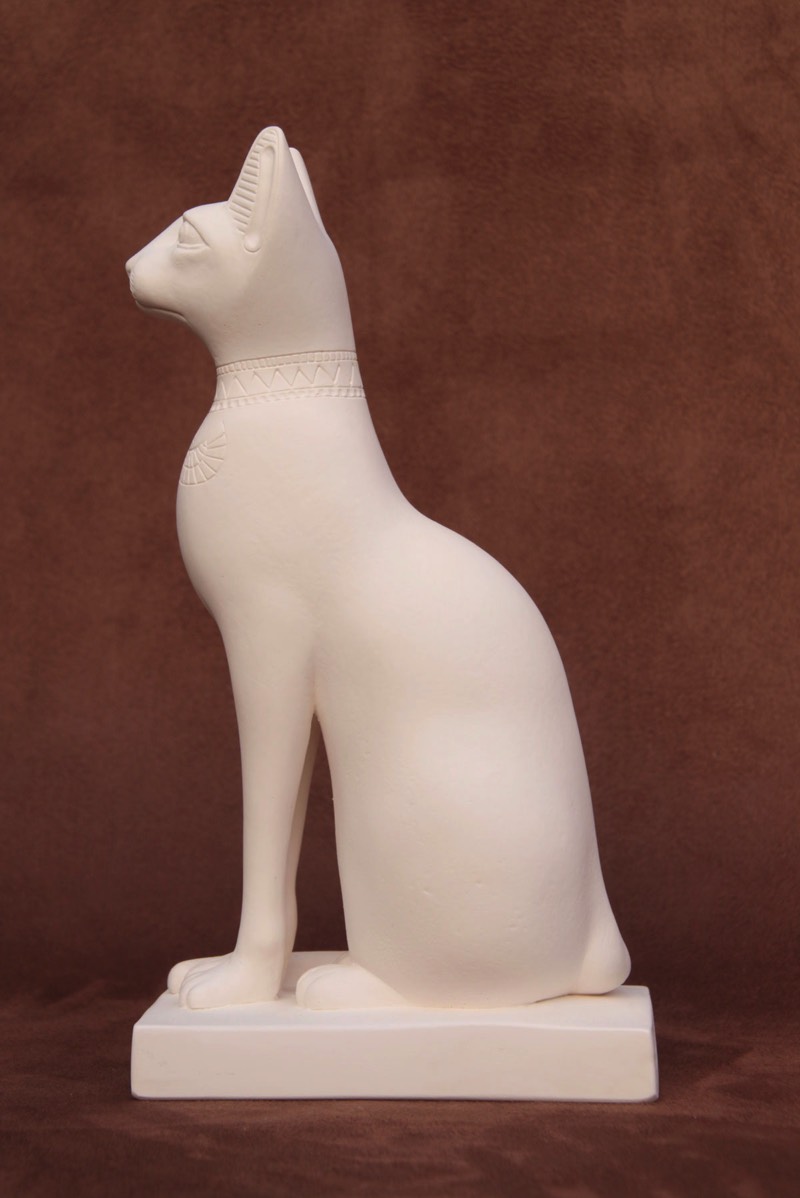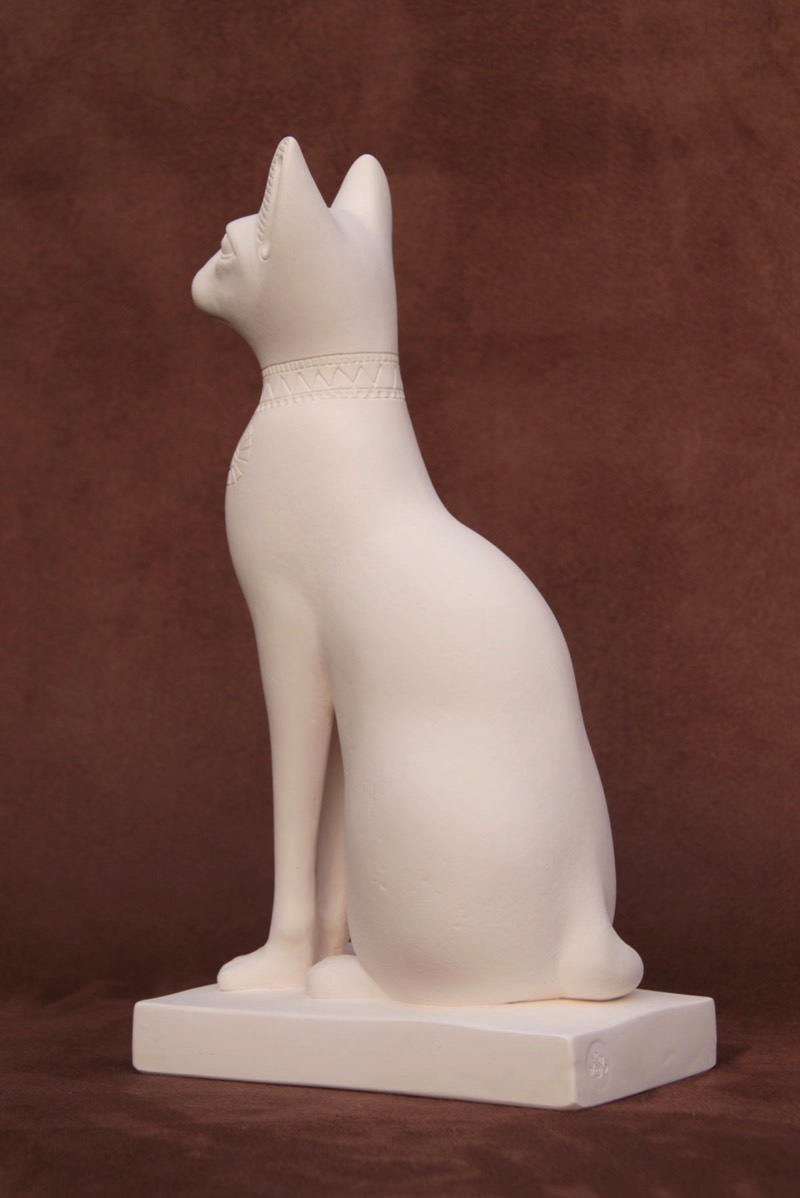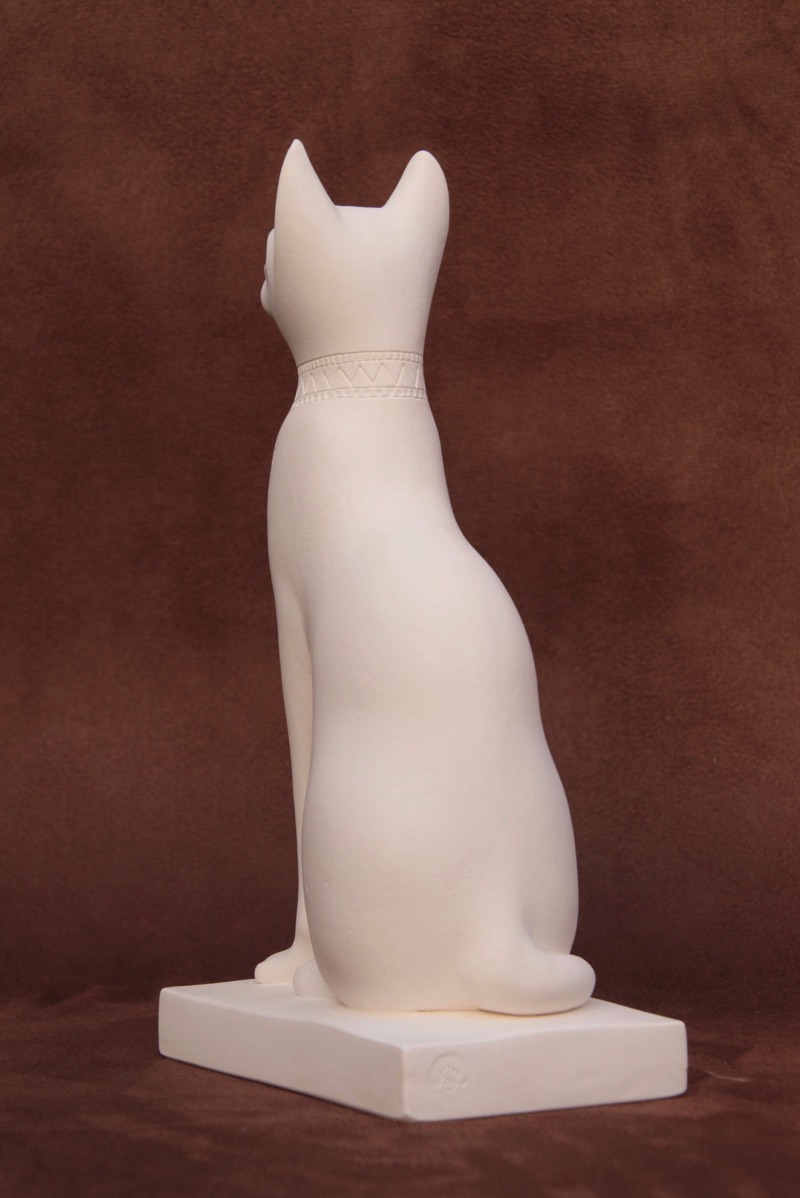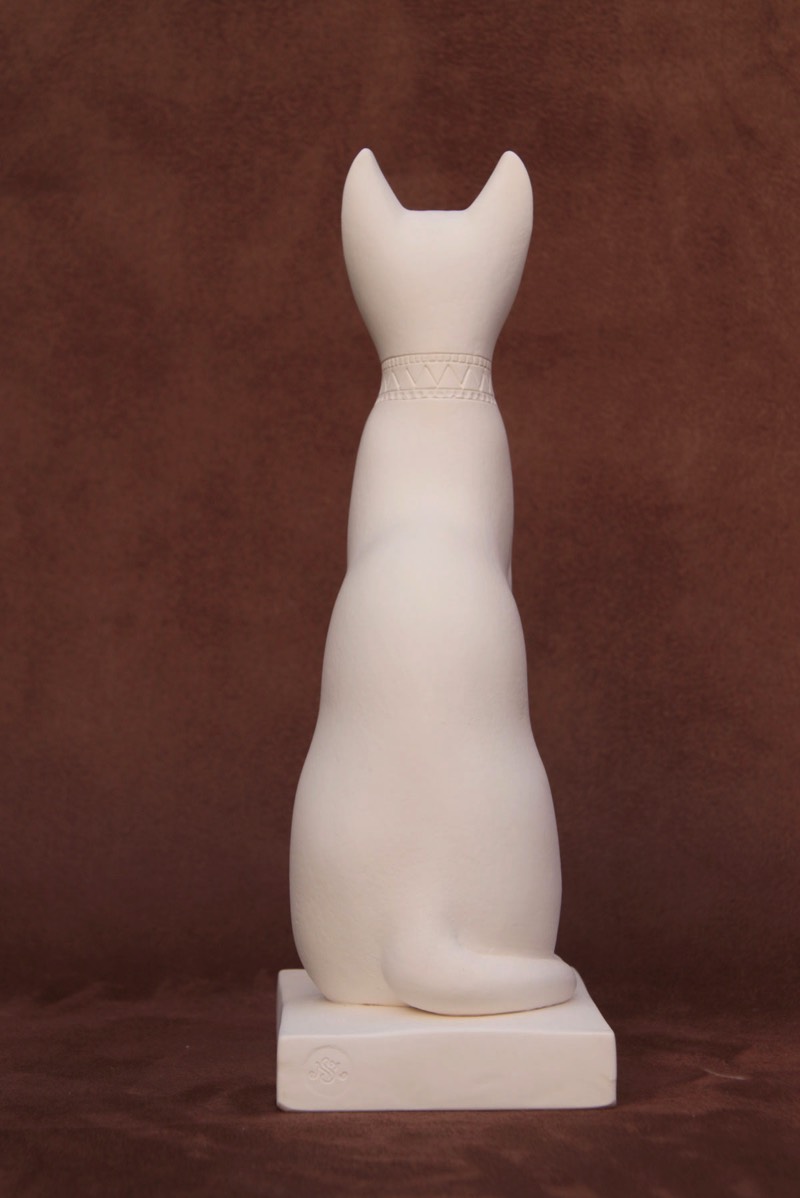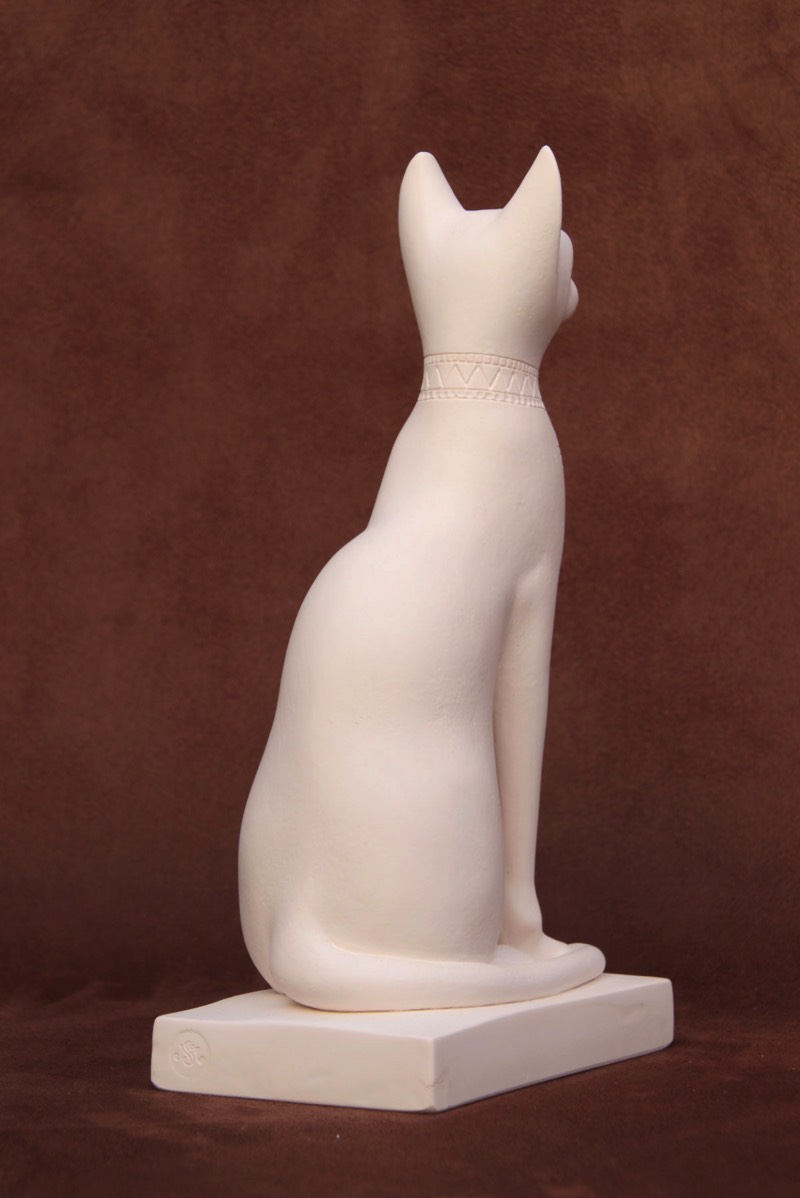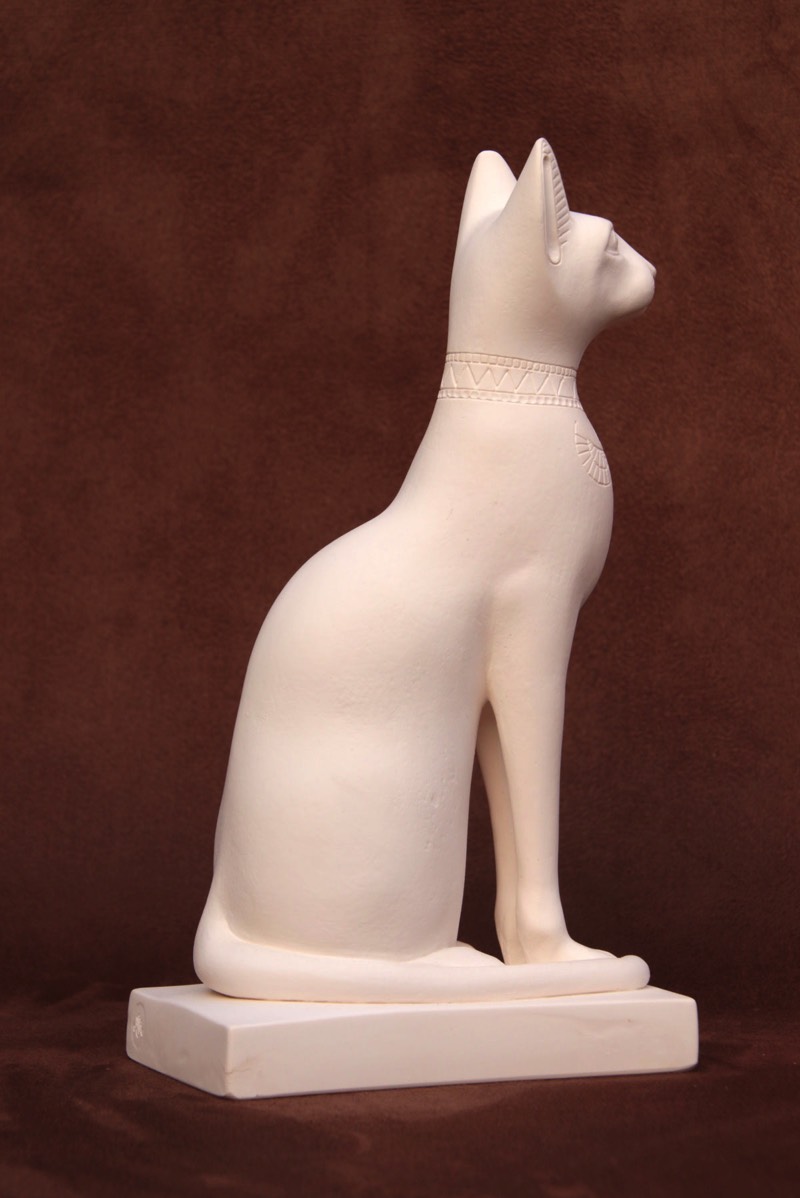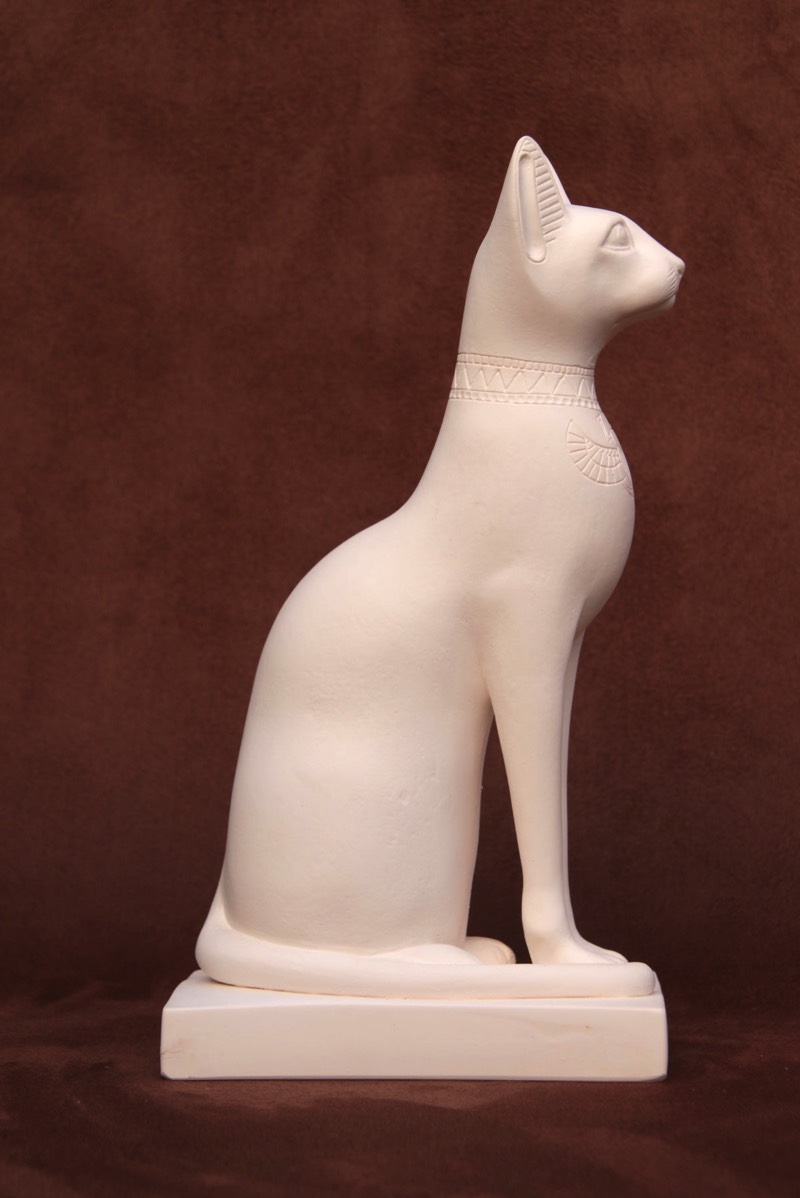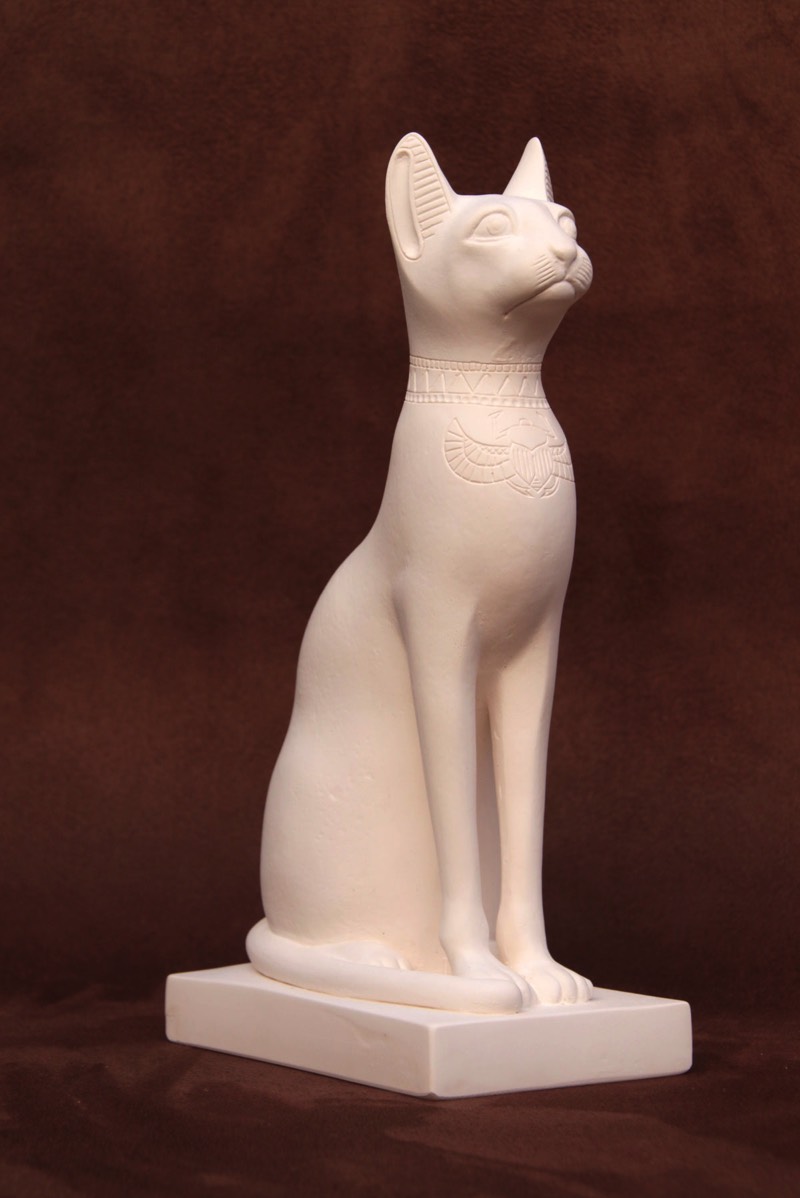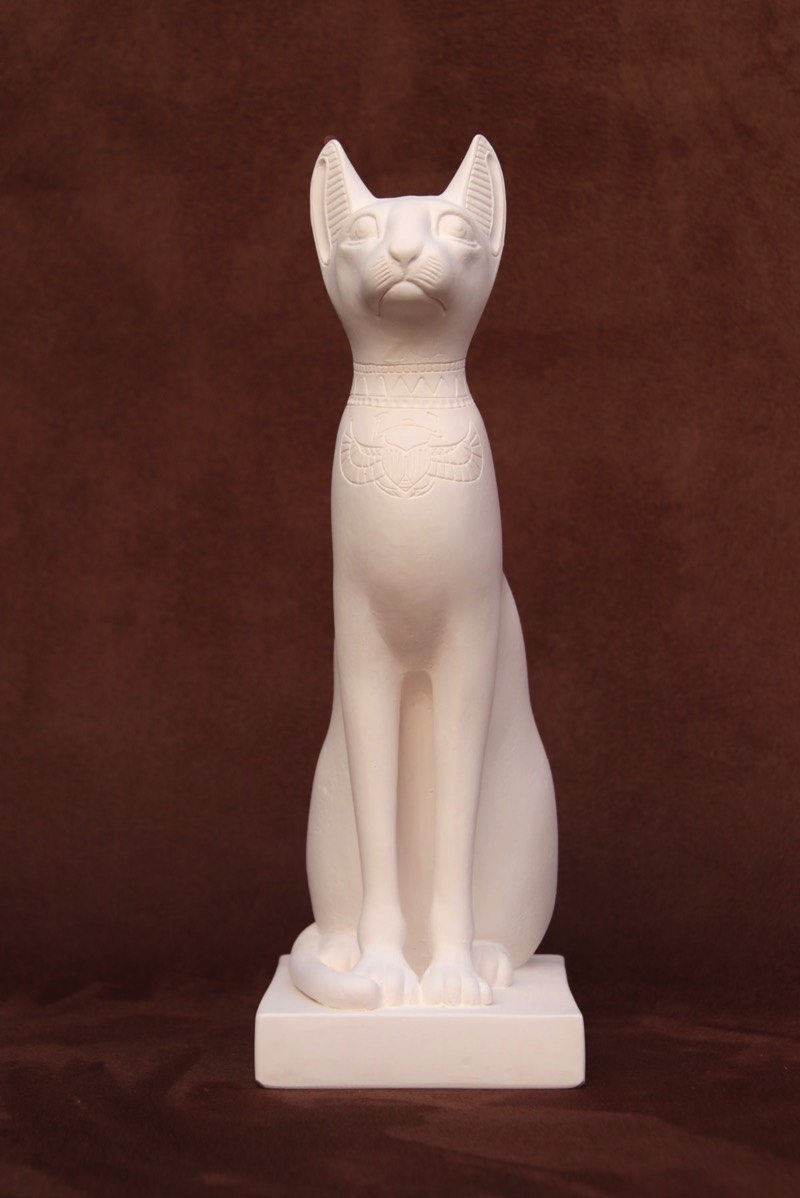
Egyptian Animal Deity Collection
Anubis (Black with Gold)
Guardian of the underworld, was the original Ancient Egyptian God of the dead (a role later associated with Osiris), and is usually portrayed as a man with the head of a jackal. This sculpture is based on the one found in the tomb of Tutankhamun, and is unusual in that it depicts Anubis as a full jackal.
More Info
Anubis had many tasks to perform such as watching over the mummification process to ensure that all is done properly and conducting the souls through the underworld, and testing their knowledge of the gods and their faith.
He would also place the heart of the deceased on the Scales of Justice during the Judging of the Heart, to determine the worthiness of the individual to enter the realm of the dead.
In Ancient Egypt, wild dogs and jackals are said to have scavenged and patrolled the peripheries of the deserts, and it is thought that the first tombs were constructed to protect the burial sites of the dead. For the Ancient Egyptians, the colour black was closely associated with fertility.
It is thought that the portrayal of Anubis as black in colour as opposed to the natural brown colour of a Jackals hide, signifies themes of rebirth and the afterlife.
Dimensions metric:
Hight: 235mm
Depth: 305mm
Width: 85mm
Dimensions imperial:
Hight: 9.3'
Depth: 12'
Width: 3.4'
He would also place the heart of the deceased on the Scales of Justice during the Judging of the Heart, to determine the worthiness of the individual to enter the realm of the dead.
In Ancient Egypt, wild dogs and jackals are said to have scavenged and patrolled the peripheries of the deserts, and it is thought that the first tombs were constructed to protect the burial sites of the dead. For the Ancient Egyptians, the colour black was closely associated with fertility.
It is thought that the portrayal of Anubis as black in colour as opposed to the natural brown colour of a Jackals hide, signifies themes of rebirth and the afterlife.
Dimensions metric:
Hight: 235mm
Depth: 305mm
Width: 85mm
Dimensions imperial:
Hight: 9.3'
Depth: 12'
Width: 3.4'
Anubis (Black)
Guardian of the underworld, was the original Ancient Egyptian God of the dead (a role later associated with Osiris), and is usually portrayed as a man with the head of a jackal. This sculpture is based on the one found in the tomb of Tutankhamun, and is unusual in that it depicts Anubis as a full jackal.
More Info
Anubis had many tasks to perform such as watching over the mummification process to ensure that all is done properly and conducting the souls through the underworld, and testing their knowledge of the gods and their faith.
He would also place the heart of the deceased on the Scales of Justice during the Judging of the Heart, to determine the worthiness of the individual to enter the realm of the dead.
In Ancient Egypt, wild dogs and jackals are said to have scavenged and patrolled the peripheries of the deserts, and it is thought that the first tombs were constructed to protect the burial sites of the dead. For the Ancient Egyptians, the colour black was closely associated with fertility.
It is thought that the portrayal of Anubis as black in colour as opposed to the natural brown colour of a Jackals hide, signifies themes of rebirth and the afterlife.
Height: 235mm
Width: 85mm
Depth: 305mm
He would also place the heart of the deceased on the Scales of Justice during the Judging of the Heart, to determine the worthiness of the individual to enter the realm of the dead.
In Ancient Egypt, wild dogs and jackals are said to have scavenged and patrolled the peripheries of the deserts, and it is thought that the first tombs were constructed to protect the burial sites of the dead. For the Ancient Egyptians, the colour black was closely associated with fertility.
It is thought that the portrayal of Anubis as black in colour as opposed to the natural brown colour of a Jackals hide, signifies themes of rebirth and the afterlife.
Height: 235mm
Width: 85mm
Depth: 305mm
Anubis (White)
Guardian of the underworld, was the original Ancient Egyptian God of the dead (a role later associated with Osiris), and is usually portrayed as a man with the head of a jackal. This sculpture is based on the one found in the tomb of Tutankhamun, and is unusual in that it depicts Anubis as a full jackal.
More Info
Anubis had many tasks to perform such as watching over the mummification process to ensure that all is done properly and conducting the souls through the underworld, and testing their knowledge of the gods and their faith.
He would also place the heart of the deceased on the Scales of Justice during the Judging of the Heart, to determine the worthiness of the individual to enter the realm of the dead.
In Ancient Egypt, wild dogs and jackals are said to have scavenged and patrolled the peripheries of the deserts, and it is thought that the first tombs were constructed to protect the burial sites of the dead. For the Ancient Egyptians, the colour black was closely associated with fertility.
It is thought that the portrayal of Anubis as black in colour as opposed to the natural brown colour of a Jackals hide, signifies themes of rebirth and the afterlife.
Height: 235mm
Width: 85mm
Depth: 305mm
He would also place the heart of the deceased on the Scales of Justice during the Judging of the Heart, to determine the worthiness of the individual to enter the realm of the dead.
In Ancient Egypt, wild dogs and jackals are said to have scavenged and patrolled the peripheries of the deserts, and it is thought that the first tombs were constructed to protect the burial sites of the dead. For the Ancient Egyptians, the colour black was closely associated with fertility.
It is thought that the portrayal of Anubis as black in colour as opposed to the natural brown colour of a Jackals hide, signifies themes of rebirth and the afterlife.
Height: 235mm
Width: 85mm
Depth: 305mm
Egyptian Cat Goddess Bast / Black with Gold
Sacred to the Ancient Egyptians, cats were the special attribute of the goddess Bast (Bastet) and were originally depicted as fiercely protective lions.
Gradually, this image softened and the goddess Bastet was often depicted as having the body of a woman and the head of a domestic cat. She was perceived as a gentle, protective goddess.
More Info
Bastet became a household goddess and a protector of women, children and domestic cats. She was also the goddess of sunrise, music, dance, pleasure, as well as family, fertility and birth.
Bastet was one of the daughters of the sun god, Ra. A great temple was built in her honour at Bubastis in the Delta.
Available in dimensions:
(H) 360 x (W) 110 x (D) 170 mm
Bastet was one of the daughters of the sun god, Ra. A great temple was built in her honour at Bubastis in the Delta.
Available in dimensions:
(H) 360 x (W) 110 x (D) 170 mm
Egyptian Cat Goddess Bast / White
Sacred to the Ancient Egyptians, cats were the special attribute of the goddess Bast (Bastet) and were originally depicted as fiercely protective lions.
Gradually, this image softened and the goddess Bastet was often depicted as having the body of a woman and the head of a domestic cat. She was perceived as a gentle, protective goddess.
More Info
Bastet became a household goddess and a protector of women, children and domestic cats. She was also the goddess of sunrise, music, dance, pleasure, as well as family, fertility and birth.
Bastet was one of the daughters of the sun god, Ra. A great temple was built in her honour at Bubastis in the Delta.
Available in dimensions:
(H) 95 x (W) 35 x (D) 45 mm
(H) 210 x (W) 70 x (D) 110 mm
(H) 360 x (W) 110 x (D) 170 mm
Bastet was one of the daughters of the sun god, Ra. A great temple was built in her honour at Bubastis in the Delta.
Available in dimensions:
(H) 95 x (W) 35 x (D) 45 mm
(H) 210 x (W) 70 x (D) 110 mm
(H) 360 x (W) 110 x (D) 170 mm
Egyptian Animal Deity Collection
Anubis (Black with Gold)
Guardian of the underworld, was the original Ancient Egyptian God of the dead (a role later associated with Osiris), and is usually portrayed as a man with the head of a jackal. This sculpture is based on the one found in the tomb of Tutankhamun, and is unusual in that it depicts Anubis as a full jackal.
More Info
Anubis had many tasks to perform such as watching over the mummification process to ensure that all is done properly and conducting the souls through the underworld, and testing their knowledge of the gods and their faith.
He would also place the heart of the deceased on the Scales of Justice during the Judging of the Heart, to determine the worthiness of the individual to enter the realm of the dead.
In Ancient Egypt, wild dogs and jackals are said to have scavenged and patrolled the peripheries of the deserts, and it is thought that the first tombs were constructed to protect the burial sites of the dead. For the Ancient Egyptians, the colour black was closely associated with fertility.
It is thought that the portrayal of Anubis as black in colour as opposed to the natural brown colour of a Jackals hide, signifies themes of rebirth and the afterlife.
Dimensions metric:
Hight: 235mm
Depth: 305mm
Width: 85mm
Dimensions imperial:
Hight: 9.3'
Depth: 12'
Width: 3.4'
He would also place the heart of the deceased on the Scales of Justice during the Judging of the Heart, to determine the worthiness of the individual to enter the realm of the dead.
In Ancient Egypt, wild dogs and jackals are said to have scavenged and patrolled the peripheries of the deserts, and it is thought that the first tombs were constructed to protect the burial sites of the dead. For the Ancient Egyptians, the colour black was closely associated with fertility.
It is thought that the portrayal of Anubis as black in colour as opposed to the natural brown colour of a Jackals hide, signifies themes of rebirth and the afterlife.
Dimensions metric:
Hight: 235mm
Depth: 305mm
Width: 85mm
Dimensions imperial:
Hight: 9.3'
Depth: 12'
Width: 3.4'
Anubis (Black)
Guardian of the underworld, was the original Ancient Egyptian God of the dead (a role later associated with Osiris), and is usually portrayed as a man with the head of a jackal. This sculpture is based on the one found in the tomb of Tutankhamun, and is unusual in that it depicts Anubis as a full jackal.
More Info
Anubis had many tasks to perform such as watching over the mummification process to ensure that all is done properly and conducting the souls through the underworld, and testing their knowledge of the gods and their faith.
He would also place the heart of the deceased on the Scales of Justice during the Judging of the Heart, to determine the worthiness of the individual to enter the realm of the dead.
In Ancient Egypt, wild dogs and jackals are said to have scavenged and patrolled the peripheries of the deserts, and it is thought that the first tombs were constructed to protect the burial sites of the dead. For the Ancient Egyptians, the colour black was closely associated with fertility.
It is thought that the portrayal of Anubis as black in colour as opposed to the natural brown colour of a Jackals hide, signifies themes of rebirth and the afterlife.
Height: 235mm
Width: 85mm
Depth: 305mm
He would also place the heart of the deceased on the Scales of Justice during the Judging of the Heart, to determine the worthiness of the individual to enter the realm of the dead.
In Ancient Egypt, wild dogs and jackals are said to have scavenged and patrolled the peripheries of the deserts, and it is thought that the first tombs were constructed to protect the burial sites of the dead. For the Ancient Egyptians, the colour black was closely associated with fertility.
It is thought that the portrayal of Anubis as black in colour as opposed to the natural brown colour of a Jackals hide, signifies themes of rebirth and the afterlife.
Height: 235mm
Width: 85mm
Depth: 305mm
Anubis (White)
Guardian of the underworld, was the original Ancient Egyptian God of the dead (a role later associated with Osiris), and is usually portrayed as a man with the head of a jackal. This sculpture is based on the one found in the tomb of Tutankhamun, and is unusual in that it depicts Anubis as a full jackal.
More Info
Anubis had many tasks to perform such as watching over the mummification process to ensure that all is done properly and conducting the souls through the underworld, and testing their knowledge of the gods and their faith.
He would also place the heart of the deceased on the Scales of Justice during the Judging of the Heart, to determine the worthiness of the individual to enter the realm of the dead.
In Ancient Egypt, wild dogs and jackals are said to have scavenged and patrolled the peripheries of the deserts, and it is thought that the first tombs were constructed to protect the burial sites of the dead. For the Ancient Egyptians, the colour black was closely associated with fertility.
It is thought that the portrayal of Anubis as black in colour as opposed to the natural brown colour of a Jackals hide, signifies themes of rebirth and the afterlife.
Height: 235mm
Width: 85mm
Depth: 305mm
He would also place the heart of the deceased on the Scales of Justice during the Judging of the Heart, to determine the worthiness of the individual to enter the realm of the dead.
In Ancient Egypt, wild dogs and jackals are said to have scavenged and patrolled the peripheries of the deserts, and it is thought that the first tombs were constructed to protect the burial sites of the dead. For the Ancient Egyptians, the colour black was closely associated with fertility.
It is thought that the portrayal of Anubis as black in colour as opposed to the natural brown colour of a Jackals hide, signifies themes of rebirth and the afterlife.
Height: 235mm
Width: 85mm
Depth: 305mm
Egyptian Cat Goddess Bast / Black with Gold
Sacred to the Ancient Egyptians, cats were the special attribute of the goddess Bast (Bastet) and were originally depicted as fiercely protective lions.
Gradually, this image softened and the goddess Bastet was often depicted as having the body of a woman and the head of a domestic cat. She was perceived as a gentle, protective goddess.
More Info
Bastet became a household goddess and a protector of women, children and domestic cats. She was also the goddess of sunrise, music, dance, pleasure, as well as family, fertility and birth.
Bastet was one of the daughters of the sun god, Ra. A great temple was built in her honour at Bubastis in the Delta.
Height 21cm
Bastet was one of the daughters of the sun god, Ra. A great temple was built in her honour at Bubastis in the Delta.
Height 21cm
Egyptian Cat Goddess Bast / White
Sacred to the Ancient Egyptians, cats were the special attribute of the goddess Bast (Bastet) and were originally depicted as fiercely protective lions.
Gradually, this image softened and the goddess Bastet was often depicted as having the body of a woman and the head of a domestic cat. She was perceived as a gentle, protective goddess.
More Info
Bastet became a household goddess and a protector of women, children and domestic cats. She was also the goddess of sunrise, music, dance, pleasure, as well as family, fertility and birth.
Bastet was one of the daughters of the sun god, Ra. A great temple was built in her honour at Bubastis in the Delta.
Height 21cm
Bastet was one of the daughters of the sun god, Ra. A great temple was built in her honour at Bubastis in the Delta.
Height 21cm
